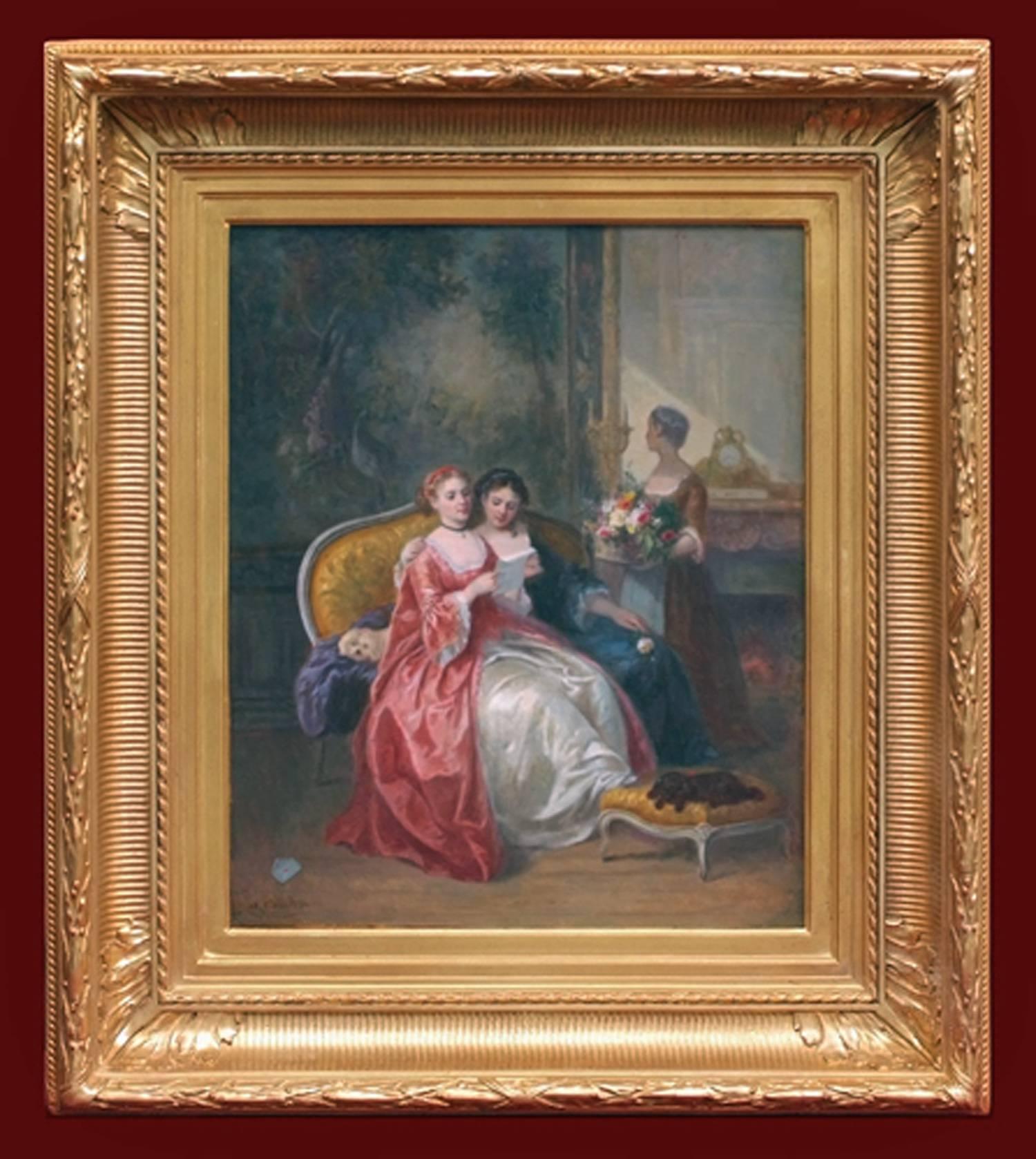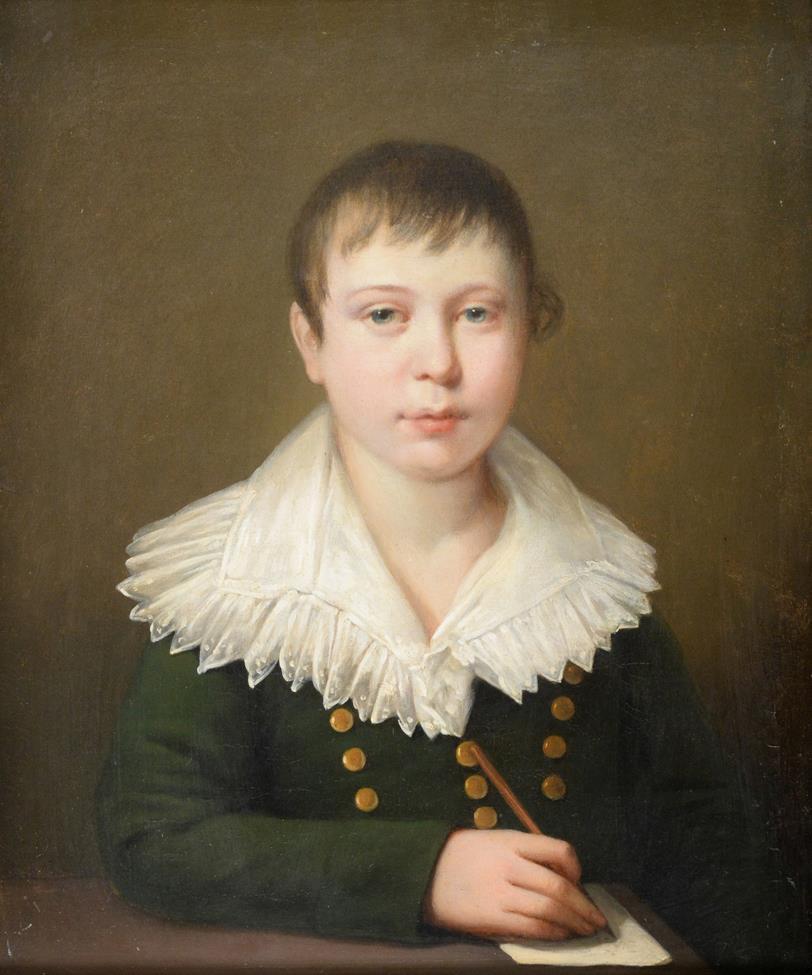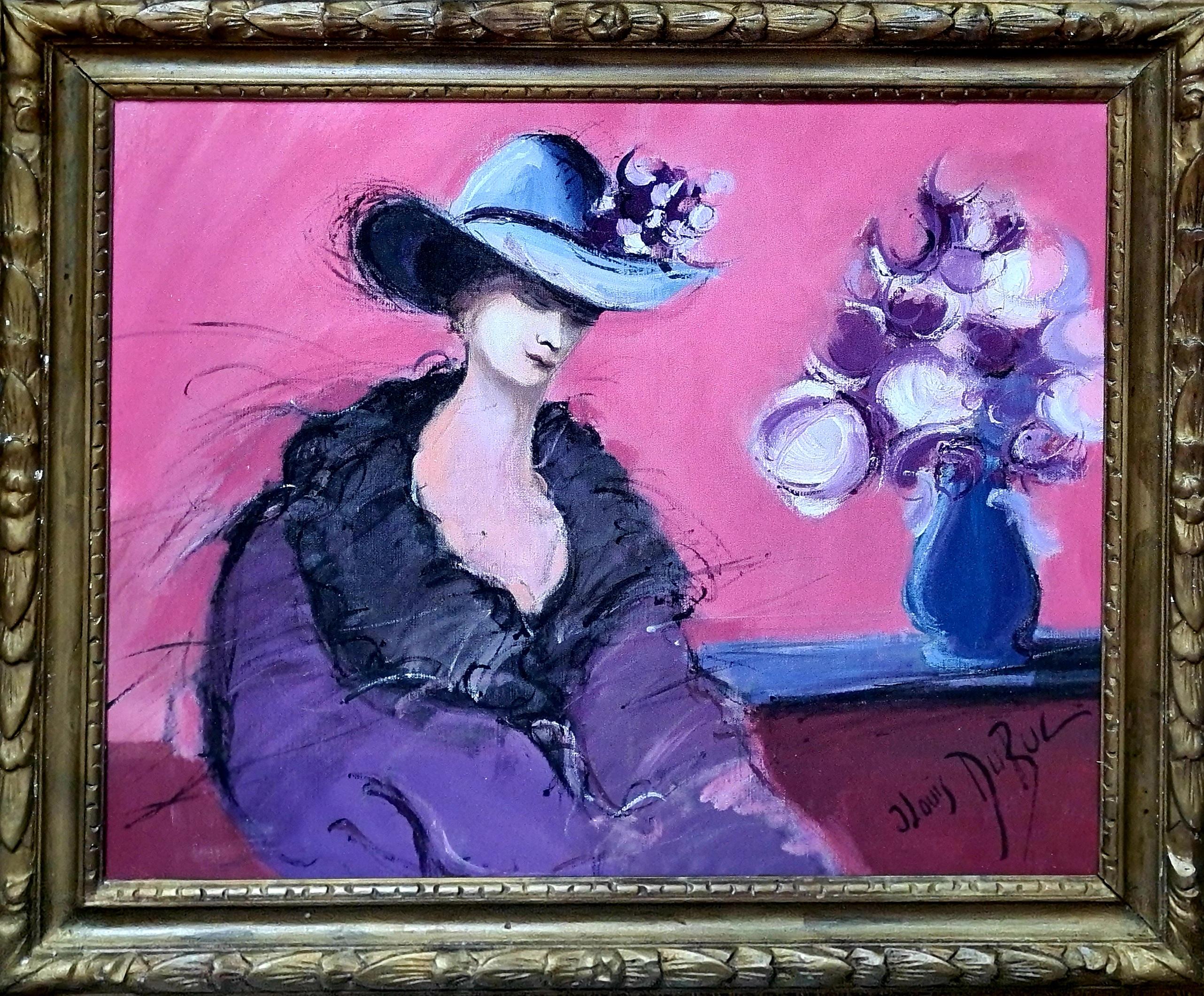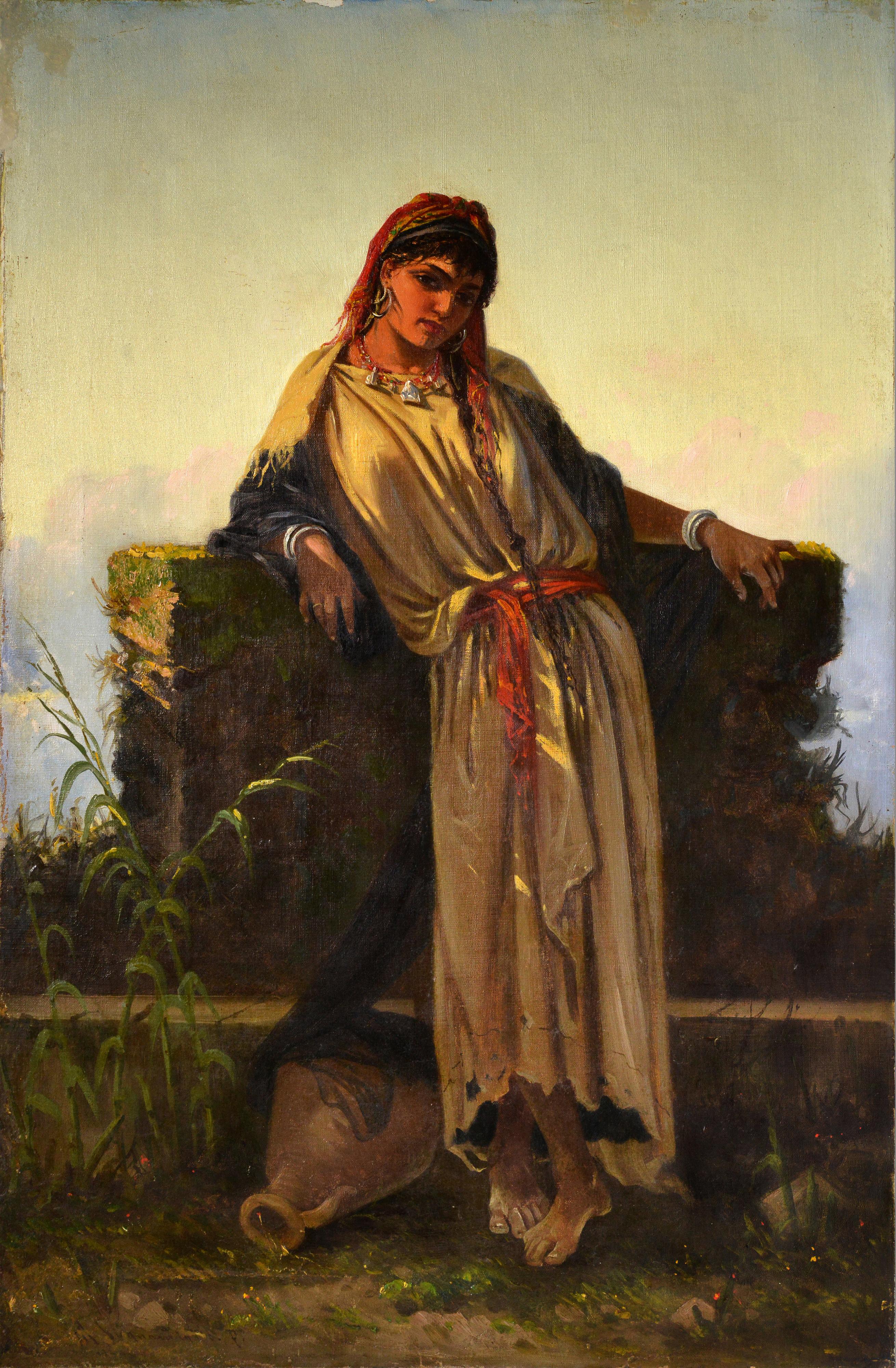Items Similar to 18th century portrait of the artist’s daughter, Catharina, playing the cello
Video Loading
Want more images or videos?
Request additional images or videos from the seller
1 of 13
Balthasar Denner 18th century portrait of the artist’s daughter, Catharina, playing the celloc.1730
c.1730
About the Item
The sitter, seated in a yellow silk gown trimmed with a pink bow playing the cello, is believed to be the artist Balthazar Denner's eldest daughter Catharina (1715-1744), after his marriage to Esther Winter in Hamburg in 1712. She is also recognisable in another portrait of the Denner family in the Hamburg Kunsthalle, painted circa 1740 by the artist's son, Jacob Denner (1722-1765). Oil on canvas in a period giltwood frame.
Provenance: Private collection, Northern Germany
Professor Helmut Borsch-Supan, Berlin, confirmed the authenticity of the painting after examining it in 2013. The painting will also be included in the forthcoming catalogue raisonnée of the artist, by Ute Mannhardt.
Balthasar Denner was born in Hamburg which was at that time part of Denmark. He began as a painter of portrait miniatures and his eye for detail continued into his larger scale portrait paintings which were greatly admired for their meticulous accuracy and made him highly sought after. Denner is recorded as being at the Prussian Academy of Arts in Berlin in 1707 before going to work at the Copenhagen court in 1712. This began his travels around the European courts, including London, Dresden, Berlin, Kiel and Amsterdam. After four years in Amsterdam from 1736 to 1740, he settled in Rostock where he died in 1749.
Denner loved music and it is said that he had his children, who were talented musicians, play for him while his sitters posed for their portraits. As well as the royals and nobles of Europe, his sitters included Georg Friedrich Handel, painted in 1726 (National Porttrait Gallery London) and in 1733 (Berlin, Deutsch Historiches) and Johann Sebastian Bach with his three sons (1733, private collection).
Denner depicted his own family playing music in a painting probably painted in London in 1728 before his departure for Germany (now in the Copenhagen Museum).
- Creator:Balthasar Denner (1685 - 1749, German)
- Creation Year:c.1730
- Dimensions:Height: 34.65 in (88 cm)Width: 29.53 in (75 cm)
- Medium:
- Movement & Style:
- Period:
- Condition:
- Gallery Location:Bath, GB
- Reference Number:1stDibs: LU9528554492
About the Seller
5.0
Vetted Seller
These experienced sellers undergo a comprehensive evaluation by our team of in-house experts.
Established in 2002
1stDibs seller since 2015
36 sales on 1stDibs
Typical response time: 1 hour
Associations
The British Antique Dealers' AssociationLAPADA - The Association of Arts & Antiques DealersInternational Confederation of Art and Antique Dealers' Associations
- ShippingRetrieving quote...Ships From: Bath, United Kingdom
- Return PolicyA return for this item may be initiated within 3 days of delivery.
More From This SellerView All
- Early 18th century portrait painting of Henrietta Paulet, Duchess of BoltonBy Maria VerelstLocated in Bath, SomersetPortrait of Henrietta Paulet, Duchess of Bolton, née Crofts, (c. 1682–1730), three-quarter length, standing on a colonnaded terrace wearing an ivory silk gown and holding a sprig of ...Category
Early 18th Century Old Masters Portrait Paintings
MaterialsCanvas, Oil
- A portrait of a lady and her daughter with an exotic birdBy Michael DahlLocated in Bath, SomersetA portrait of a lady three-quarter length, seated in an interior, wearing a red silk gown draped in a pink silk sash with an exotic bird perched on her hand and one arm resting on a stone plinth, her young daughter wearing a green silk gown standing at her side. Oil on canvas, housed in a period 'Lely' giltwood frame. This double portrait was painted at the height of Dahl's career in circa 1715 when Dahl had become firmly established as one of the leading portrait painters in Britain. Although the identities of the sitters are currently unknown, it is a sensitive depiction of a close and affectionate bond between a mother and daughter, with the young girl's hand resting affectionately on her mothers lap. The tamed exotic bird adds a charming decorative element which also serves to convey the high social status of the lady, given only the very wealthy would be able to own such a rare and expensive pet and the lively colouring of the bird's feathers is reflected in the colours of the sitters' silk gowns. Provenance: Private collection, London Michael Dahl (Stockholm 1659-1743 London) was born in Stockholm in Sweden and studied under Martin Hannibal (d 1741) and later with David Klöcker Ehrenstrahl. In 1682 he travelled to London, where he became acquainted with Godfrey Kneller and Henry Tilson, and in 1685 he left for Europe with Tilson, working briefly in Paris before continuing to Venice and Rome, where they stayed for about two years. In Rome Dahl converted to Roman Catholicism and gravitated towards the circle of Christina, former Queen of Sweden, who sat for him (Grimsthorpe Castle, Lincs). He returned to England with Tilson via Frankfurt and arrived in London in 1689, staying in England for the remainder of his career. During Dahl's absence, Kneller had consolidated his supremacy in London as the most fashionable portrait painter, but Dahl rapidly became Kneller’s closest competitor. His patrons probably had roots in the Swedish diplomatic circles, but it expanded as a result of his ability and his agreeable personality. His prices were lower than those of Kneller and he favoured softer, more diffused, colour tones and could respond to his sitters with sincerity and humanity. Politically, Kneller supported the ascendant Whigs while Dahl was a Tory, but they frequently painted the same sitters from both parties, and in spite of fundamental differences in technique and temperament, their work was sometimes similar in appearance. Dahl was prolific but rarely signed his work, and comparatively few of his portraits were engraved in mezzotint, the method used by Kneller to widen his reputation. By 1690 he had painted the aged Duke of Schomberg (engraved by William Faithorne) and Prince George of Denmark (London, Kensington Palace). He was ignored by William III but received commissions from Princess Anne, including one for a portrait of herself (Oakly Park, Ludlow, Salop). He also painted the future Duke and Duchess of Marlborough, and his informal portrait of the Duchess (Althorp House, Northants), formerly attributed to Kneller, is perhaps the most intimate of all images of her. During the 1690s he secured the patronage of Charles Seymour, the ‘Proud’ 6th Duke of Somerset, who ordered a series of seven full-length portraits of notable contemporary beauties from Dahl (1690s; Petworth House, W. Sussex, NT). This was originally a scheme similar to Kneller’s more famous ‘Hampton Court Beauties’, but the portraits were subsequently reduced to three-quarter-length formats. The features of the sitters are not individualized, but they possess a decorative, languorous glamour that recalls Lely rather than Kneller. Somerset gave Dahl further employment over the next 25 years. In 1698, following the death of Klöcker Ehrenstrahl, Dahl was offered the post of court painter at Stockholm, which he apparently refused, preferring to remain in London at his studio in Leicester Fields, near the Swedish legation. In about 1700 he was joined by a young compatriot, Hans Hysing, who worked with him for many years. Dahl seems not to have married until after 1708, He had a son Michael (d. 1741), also a painter, of whose work nothing is known, and two daughters. After the accession of Queen Anne in 1701, she and Prince George sat for a number of official portraits. His royal patronage ceased with Queen Anne’s death, and when Dahl refused to paint the infant Duke of Cumberland in 1722. He was suspected of Jacobite sympathies, and relations had cooled between him and the Swedish legation. However, his practice continued to prosper, and he acquired another important patron in Edward Harley, 2nd Earl of Oxford, who shared his political views and whose circle included the architect James Gibbs and the poets Matthew Prior and Alexander Pope, all of whom Dahl painted. Oxford commissioned several portraits of himself. In the earliest (1719; Welbeck Abbey...Category
Early 18th Century Old Masters Portrait Paintings
MaterialsCanvas, Oil
- English 18th century portrait of Henrietta Pelham-Holles, Duchess of Newcastle.By Charles JervasLocated in Bath, SomersetPortrait of Henrietta Pelham-Holles (née Godolphin) (1701-1776), Duchess of Newcastle, standing in a wooded landscape with a river beyond, three-quarter length wearing an ivory silk ...Category
1720s Old Masters Portrait Paintings
MaterialsOil, Canvas
- 17th century portrait of a ladyBy Nicolaes MaesLocated in Bath, SomersetPortrait of a lady richly dressed in a purple silk gown with white sleeves, a gold coloured cloak draped across one shoulder, her blonde curls worn up...Category
17th Century Old Masters Portrait Paintings
MaterialsCanvas, Oil
- 17th century portrait of a lady seated in an interiorLocated in Bath, SomersetPortrait of a lady, believed to be Henrietta Hyde (née Boyle), Countess of Rochester, (1646-1687) three quarter length, wearing an amber coloured silk gown, with an embroidered blue mantle, seated in an interior. Oil on canvas in a ‘Lely’ frame with the Hornby Castle inventory number 60 attached on the reverse. Provenance: By descent through the Dukes of Leeds, Hornby Castle, Yorkshire; Christie's, London - The Property of the 10th Duke of Leeds Will Trust, 30th October, 2014, Lot 106. Private collection Guernsey. Hornby Castle, Catalogue of Pictures, London, 1898, p. 5, no.60. Historical and descriptive catalogue of pictures belonging to His Grace The Duke of Leeds, London, 1902, p. 24, no. 60. Henrietta was born in Wiltshire, to Sir Richard Boyle, 2nd Earl of Cork and Elizabeth Boyle, Countess of Cork. In 1665, she married Laurence Hyde, 1st Earl of Rochester, son of Edward Hyde, 1st Earl of Clarendon and Frances Aylesbury. They had four children. As sister-in-law of Anne Hyde, the Duchess of York she was appointed as governess to her daughter, Princess Anne (the future Queen) between 1677 and 1682. Like most of the Boyle dynasty, who in the space of two generations had become almost all-powerful in the south of Ireland, Henrietta was strong-minded and acquisitive, and could be ruthless in asserting her rights. During the last two years of her life, when her husband was Chief Minister to his brother-in-law King James II...Category
17th Century Old Masters Portrait Paintings
MaterialsCanvas, Oil
- 18th century English portrait of a lady beside an urn, with a basket of flowersBy Tilly KettleLocated in Bath, SomersetPortrait of a lady wearing a white gown with a red cloak, pearls in her hair and draped over one shoullder, standing beside a classical urn with a basket of flowers, c.1765. The portrait is believed to be a companion portrait of a John (1741-1816) or James (1751-1807) Durno which is housed in an identical frame. The sitter is possibly either the wife of John who was Janes Byres of Stonywood or John and James's sister Elizabeth. (James never married). The Durno family were based around the Aberdeen area of Scotland and John was an advocate in the area and then later a customs official in Jamaica. James was a successful timber merchant, spending time in the Baltic before being made His Majesty's Consul in Memel, Prussia. The portrait is likely to have been painted before Tilly travelled to India in 1768, when John, Jane and Elizabeth would have been in their twenties. We are gtrateful to Mark Beattie for sharing his family knowlege and research on the portrait. Provenance: With W. C. Beattie in the mid 19th century, and by descent through the family Private collection, Kent With thanks to Hugh Belsey who has confirmed this to be the work of Tilly Kettle from photographs. Tilly Kettle (1735-1786) was born in London, the third of six children by Henry Kettle (c.1704-c.1773), a coach painter, and his wife Ann. He attended William Shipley...Category
18th Century Old Masters Portrait Paintings
MaterialsCanvas, Oil
You May Also Like
- Painting 19th Century Romantic Courtiers Genre SceneLocated in Saint-Ouen, FRCourtiers Party in the Park in 18th Century In the Taste of Nicolas Lancret (1690-1743) Oil on canvas Frame gilded with leaves Dim canvas : 73 X 59 cm Dim frame : 100 X 87 cmCategory
1850s Old Masters Portrait Paintings
MaterialsOil
- 19th Century Painting Interior and Genre SceneBy Jean Alexandre Rémy CouderLocated in Saint-Ouen, FRCOUDER Alexandre Jean Rémy (1808-1879) Reading on the sofa Oil on canvas signed low left Old original frame gilded with leaves Dim canvas : 47 X 39 cm Di...Category
1860s Old Masters Interior Paintings
MaterialsOil
- Painting 19th century old master rural daily lifeBy Henri-Joseph CastaingLocated in Saint-Ouen, FRCASTAING Henri Joseph (1860-1918) Young girl at the source Oil on canvas signed low left Frame gilded with gold leaves Dim canvas : 100 X 66 cm Dim frame : 121 X 86 cm CASTAING Henr...Category
1890s Old Masters Portrait Paintings
MaterialsOil
- Fine 1800's Portrait of Young Aristocratic Boy with Letter & Pen Oil on CanvasLocated in Cirencester, GloucestershirePortrait of a Young Aristocrat French School, circa 1800's circle of Louis Leopold Boilly (1761-1845) oil painting on canvas, framed canvas: 16 x 13.5 inches frame: 21 x 18 inches p...Category
Early 19th Century Rococo Portrait Paintings
MaterialsOil, Canvas
- La Femme au Chapeau Bleu, Large French Fauvist Figurative Oil on Canvas.By Jean-Louis DubucLocated in Cotignac, FRLarge scale colourful figurative portrait of a fashionable lady in a blue hat by French artist Jean-Louis Dubuc. The painting is signed bottom right and titled to the rear cross stre...Category
Late 20th Century Fauvist Portrait Paintings
MaterialsCanvas, Oil, Acrylic
- Italian genre portrait Middle Eastern beauty at a well 19th century oil paintingLocated in Stockholm, SEBedouin girl posing for the painter in late sunlight (sunset). Was painted by Cavaliero Antonio Scognamiglio ca. 1870-1880, most likely in Cairo as similar work of smaller size was i...Category
Late 19th Century Realist Portrait Paintings
MaterialsCanvas, Oil
Recently Viewed
View AllMore Ways To Browse
The Den
Master Of The Die
Playing Music
Portrait Musician
Large Scale Portrait
Record Play
Playing Music Painting
Antique Den
European Painting 18th Century
18th C Painting
18th Century Pink
Antique Portrait Miniatures
Antique Portrait Miniature
Early Dresden
Framed Miniature Portraits
Portrait Of Danish
Prussian Painting
Antique Portrait Miniature Painting Paintings





